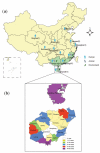Endemic Melioidosis in Southern China: Past and Present
- PMID: 30823573
- PMCID: PMC6473618
- DOI: 10.3390/tropicalmed4010039
Endemic Melioidosis in Southern China: Past and Present
Abstract
Melioidosis is a severe tropical infectious disease caused by the soil-dwelling bacterium Burkholderia pseudomallei, predominantly endemic to Southeast Asia and northern Australia. Between the 1970s and the 1990s, the presence of B. pseudomallei causing melioidosis in humans and other animals was demonstrated in four coastal provinces in southern China: Hainan, Guangdong, Guangxi, and Fujian, although indigenous cases were rare and the disease failed to raise concern amongst local and national health authorities. In recent years, there has been a rise in the number of melioidosis cases witnessed in the region, particularly in Hainan. Meanwhile, although China has established and maintained an effective communicable disease surveillance system, it has not yet been utilized for melioidosis. Thus, the overall incidence, social burden and epidemiological features of the disease in China remain unclear. In this context, we present a comprehensive overview of both historical and current information on melioidosis in Southern China, highlighting the re-emergence of the disease in Hainan. Surveillance and management strategies for melioidosis should be promoted in mainland China, and more research should be conducted to provide further insights into the present situation.
Keywords: Burkholderia pseudomallei; China; epidemiology; melioidosis.
Conflict of interest statement
The authors declare no conflict of interest.
Figures




Similar articles
-
The prevalence and distribution of Burkholderia pseudomallei in rice paddy within Hainan, China.Acta Trop. 2018 Nov;187:165-168. doi: 10.1016/j.actatropica.2018.08.007. Epub 2018 Aug 7. Acta Trop. 2018. PMID: 30096286
-
First co-infection case of melioidosis and Japanese encephalitis in China.BMC Infect Dis. 2018 Sep 4;18(1):452. doi: 10.1186/s12879-018-3364-6. BMC Infect Dis. 2018. PMID: 30180813 Free PMC article.
-
Genetic diversity and transmission patterns of Burkholderia pseudomallei on Hainan island, China, revealed by a population genomics analysis.Microb Genom. 2021 Nov;7(11):000659. doi: 10.1099/mgen.0.000659. Microb Genom. 2021. PMID: 34762026 Free PMC article.
-
Pseudomonas pseudomallei and melioidosis in China.Chin Med J (Engl). 1992 Sep;105(9):775-9. Chin Med J (Engl). 1992. PMID: 1283844 Review.
-
Melioidosis research in China.Acta Trop. 2000 Nov 2;77(2):157-65. doi: 10.1016/s0001-706x(00)00139-x. Acta Trop. 2000. PMID: 11080506 Review.
Cited by
-
The first imported case of melioidosis in a patient in central China.Emerg Microbes Infect. 2019;8(1):1223-1228. doi: 10.1080/22221751.2019.1654839. Emerg Microbes Infect. 2019. PMID: 31429668 Free PMC article.
-
Wild animal and zoonotic disease risk management and regulation in China: Examining gaps and One Health opportunities in scope, mandates, and monitoring systems.One Health. 2021 Aug 5;13:100301. doi: 10.1016/j.onehlt.2021.100301. eCollection 2021 Dec. One Health. 2021. PMID: 34401458 Free PMC article. Review.
-
A novel lytic phage potentially effective for phage therapy against Burkholderia pseudomallei in the tropics.Infect Dis Poverty. 2022 Aug 4;11(1):87. doi: 10.1186/s40249-022-01012-9. Infect Dis Poverty. 2022. PMID: 35927751 Free PMC article.
-
Enhancing Diagnosis and Treatment Adjustments for Travelers Infected with Burkholderia pseudomallei: A Case Report - Beijing Municipality, China, June 2023.China CDC Wkly. 2024 Jun 21;6(25):614-616. doi: 10.46234/ccdcw2024.090. China CDC Wkly. 2024. PMID: 38933040 Free PMC article.
-
The Epidemiology of Melioidosis and Its Association with Diabetes Mellitus: A Systematic Review and Meta-Analysis.Pathogens. 2022 Jan 25;11(2):149. doi: 10.3390/pathogens11020149. Pathogens. 2022. PMID: 35215093 Free PMC article.
References
-
- Limmathurotsakul D., Golding N., Dance D.A., Messina J.P., Pigott D.M., Moyes C.L., Rolim D.B., Bertherat E., Day N.P., Peacock S.J., et al. Predicted global distribution of Burkholderia pseudomallei and burden of melioidosis. Nat. Microbiol. 2016;1:15008. doi: 10.1038/nmicrobiol.2015.8. - DOI - PubMed
Publication types
Grants and funding
LinkOut - more resources
Full Text Sources
Miscellaneous

